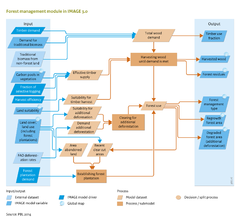Forest management/Data uncertainties limitations: Difference between revisions
Jump to navigation
Jump to search
No edit summary |
m (Text replace - "FAO, 2001" to "FAO, 2001a") |
||
| Line 10: | Line 10: | ||
The regularly published FAO Forest Resource Assessment reports on the amount of industrially produced wood and the extent of primary and secondary forests, but not on the area from which these amounts are harvested, or on the use of different types of forest management. Moreover, the amount of wood produced in deforestation processes is not reported, probably due to the illegal nature of many such operations. | The regularly published FAO Forest Resource Assessment reports on the amount of industrially produced wood and the extent of primary and secondary forests, but not on the area from which these amounts are harvested, or on the use of different types of forest management. Moreover, the amount of wood produced in deforestation processes is not reported, probably due to the illegal nature of many such operations. | ||
Another lack in available data on forest use concerns the extent of illegal logging which is not captured in the FAO statistics and for which any very wildly estimates are available made for this (Nellemann & Interpol, 2012). As part of this, the data on extent of informal fuel wood collection from forests in developing countries are lacking (FAO, | Another lack in available data on forest use concerns the extent of illegal logging which is not captured in the FAO statistics and for which any very wildly estimates are available made for this (Nellemann & Interpol, 2012). As part of this, the data on extent of informal fuel wood collection from forests in developing countries are lacking (FAO, 2001a, 2008). Only part of the fuel wood demand is assumed to be met by industrial forest harvesting, and estimates of total fuel wood demand are highly uncertain. Another uncertainty is the starting point: the state of forest use by age cohort as it was in 1970. As forests take from several decades to even a century to regrow after cutting, the effect of uncertainties in forest-use extends far into the future. Establishing a correct forest-use situation for 1970, requires assumptions or information on the forest use over the preceding century. However, there is no data available on historical forest use before 1970. | ||
=== Limitations === | === Limitations === | ||
In IMAGE, it is generally assumed that forests begin to regrow as soon as wood has been harvested, unless agriculture expands into that exact location. The only real modelled driver of deforestation is the net expansion of agriculture per certain region. However, there are many drivers of deforestation that are not related to agricultural expansion. So far, no global assessment model has included these other drivers, and therefore deforestation rates are calibrated, as they are in IMAGE. Although, the assumptions on these other drivers are highly uncertain, they largely determine future deforestation and deforestation emissions in scenario simulations. | In IMAGE, it is generally assumed that forests begin to regrow as soon as wood has been harvested, unless agriculture expands into that exact location. The only real modelled driver of deforestation is the net expansion of agriculture per certain region. However, there are many drivers of deforestation that are not related to agricultural expansion. So far, no global assessment model has included these other drivers, and therefore deforestation rates are calibrated, as they are in IMAGE. Although, the assumptions on these other drivers are highly uncertain, they largely determine future deforestation and deforestation emissions in scenario simulations. | ||
}} | }} | ||
Revision as of 11:00, 2 May 2014
Parts of Forest management/Data uncertainties limitations
| Component is implemented in: |
| Components: |
| Related IMAGE components |
| Projects/Applications |
| Key publications |
| References |
